Sony Alpha SLT-A33
-
-
Written by Gordon Laing
In depth
Sony Alpha SLT-A33 design
Externally, the Sony Alpha SLT-A33 is styled like a traditional DSLR, with few clues to the unique technology housed within other than a deeper than average viewfinder housing. At first glance you’d also be forgiven for assuming it’s roughly the same size as a typical DSLR too, but place the SLT-A33 side-by-side against one and you’ll notice it’s slightly narrower and about 1cm shorter than most budget models. The only dimension that’s shared with a typical DSLR is its thickness as the SLT-A33 is designed to use standard Sony Alpha lenses and hence requires a specific mount to sensor distance.
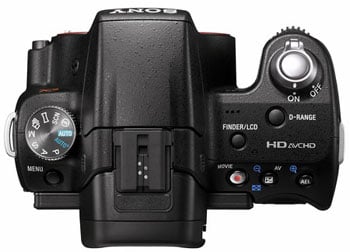 | |
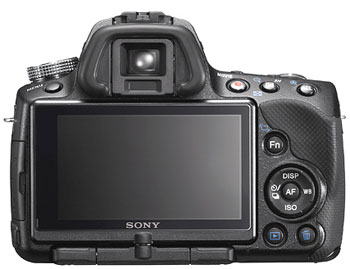 | |
Once in your hands, the SLT-A33 body feels compact but comfortable. The shorter height of the camera means you’ll typically only have two rather than three fingers wrapped-around the grip, leaving your little finger dangling below, but you can still hold it securely with small to medium-sized lenses and there’s no pinching of your fingertips either. Anyone regularly using bigger or heavier lenses though would be advised to try the combination in person as it almost certainly won’t be as comfortable as a full-sized DSLR. Fitted with the kit lens though, the SLT-A33 feels just fine.
While the SLT-A33 is smaller than a typical budget DSLR though, it isn’t significantly lighter. Weighing 492g with battery and card, the SLT-A33 is only 8g shy of the body-plus-battery weights of the Canon EOS 1000D / XS and Nikon D3100. Thanks to its standard Alpha mount, there’s also no size or weight benefit to the SLT-A33 once you’ve fitted a lens either. This shouldn’t come as too much of a surprise though as despite switching a moving mirror and optical viewfinder for a fixed mirror and electronic viewfinder, the SLT-A33 shares roughly the same components as a standard Alpha DSLR.
If you’re looking for a more significant saving in size and weight over a traditional DSLR while retaining the large sensor and removable lenses, you’ll need to go for a mirrorless ‘EVIL’ model, although most, including Sony’s own NEX-3 and NEX-5, sacrifice a viewfinder as standard. Arguably the closest rival to the SLT-A33 in terms of a hybrid camera offering both a screen and viewfinder for composition is the Panasonic Lumix DMC-GH2. Based on the Micro Four Thirds standard, the GH2 dispenses with a mirror altogether and exploits a new mount for a shorter lens to sensor distance. This allows the GH2 to enjoy a thinner body, albeit one with roughly the same width and height as the SLT-A33.
While the GH2 body plus battery only works out 48g lighter than the SLT-A33, the Micro Four Thirds standard allows smaller and lighter lenses. Fit the standard 14-42mm (28-84mm equivalent) kit lens to the GH2 and it becomes almost 100g lighter and noticeably smaller than the SLT-A33 equipped with its 18-55mm (27-83mm equivalent) kit lens. In this respect, the SLT-A33 is held back in ultimate size and weight by the decision to use standard Alpha mount lenses, although the obvious benefit is a large existing catalogue to choose from.
In terms of controls, the SLT-A33 will be immediately familiar to any DSLR owner. There’s a mode dial on the upper left side, and a scattering of buttons on the upper and rear right surfaces including a traditional four-way rocker. You’ll find dedicated buttons for the D-Range (DRO) setting, ISO, White Balance and drive options, along with a button which starts filming video regardless of the mode you’re currently using.
The Fn button isn’t customisable, but does fire-up a very usable menu system which displays a column of settings on the left and right sides of the image view. The available options vary depending on the current mode, but set to Program, the Fn menu presents quick access to the Drive, Flash and AF mode, AF Area, Face Detection and Smile Shutter options on the left, and Sensitivity, Metering, Flash Compensation, White Balance, DRO / Auto HDR and Creative Style on the right.
Sony Alpha SLT-A33 Function Menu: 3:2 / 16:9 aspect ratio | ||
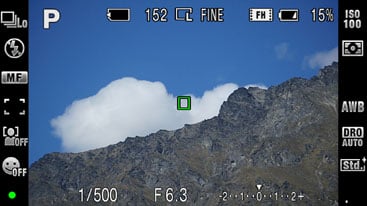 | 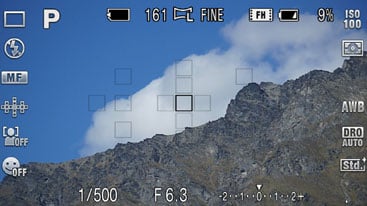 | |
| Function menu when shooting in 3:2 aspect ratio | Function menu when shooting in 16:9 aspect ratio | |
After pressing the Fn button, simply use the rocker control to highlight the desired setting before pressing the central button to present a menu of options. Quicker still, with the desired option highlighted, the finger dial can be used to directly adjust most of the settings; this also avoids the annoying quirk of the user interface which throws you out of the Fn menu every time you confirm an option, slowing down multiple changes.
Three flaps on the left side of the body hide the various ports: behind the largest flap you’ll find a Mini HDMI jack and a standard USB port, while below are two smaller flaps, one covering the remote control port and the other a 3.5mm microphone jack. Like other recent Sony cameras, there’s no connectivity to TVs without HDMI.
The SLT-A33’s HDMI port outputs a 1080i signal during normal composition and while recording video, but look a little closer at images grabbed over HDMI and you’ll notice a difference to the way most cameras operate. During normal Live View composition, the actual image appears to be upscaled from standard definition video with fuzzy details when viewed at 100%. Start recording video though and the image output over HDMI becomes much sharper; indeed we’d say the SLT-A33 outputs genuine Full HD video over its HDMI port while recording video.
You can see an example of this below where we’ve grabbed frames over HDMI during Live View and when recording video, then taken 100% crops from each. It’s clear how the HDMI output while recording video is much higher resolution than during Live View composition. Note the lens focal length and composition were the same for each frame-grab, but as explained in the Movie Mode page, the A33 slightly crops the field of view once you start recording – hence the slightly tighter crop below right.
Sony Alpha SLT-A33 100% crop from HDMI output during Live View | Sony Alpha SLT-A33 100% crop from HDMI output during Movie recording | |
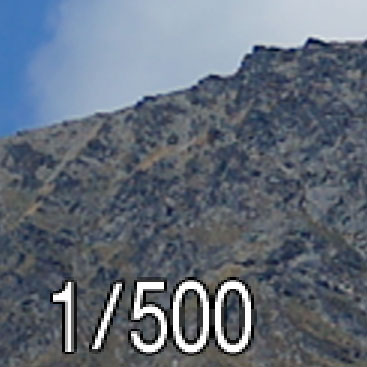 | 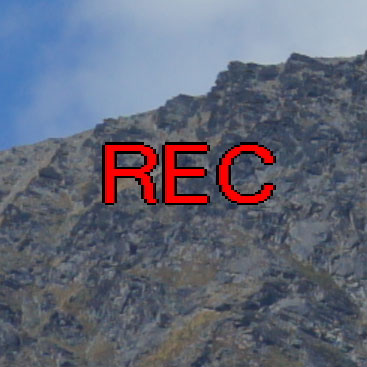 | |
100% crop from HDMI output | 100% crop from HDMI output | |
This is in complete contrast to most cameras with HD video which tend to output a Full HD image over HDMI while composing, before downgrading to standard definition once you start recording video. This doesn’t make any difference to the quality of the recorded footage, but higher-end videographers who connect external monitors to aid filming obviously prefer a high resolution output. Annoyingly though the A33 scuppers much of the usefulness of this feature by scattering a variety of icons over the image which can’t be switched off.
Compare this to the Panasonic Lumix GH2 which can output a completely clean 1080i signal over HDMI while recording video – while also keeping its main screen active with a selection of shooting information if desired. This kind of feature will only impact a small number of owners, but positions the GH2 more towards pro video work than the A33.
Moving onto audio capture, the SLT-A33 features built-in stereo microphones on either side of the viewfinder head – a nice feature considering most video-equipped DSLRs only have mono mics, but it should be noted Panasonic’s GH2 also features built-in stereo mics.
As mentioned earlier, the SLT-A33 also features a 3.5mm jack to connect an external microphone. Sony labels this jack as ‘plug-in power’, and claims it’ll power compatible mics, but thankfully it didn’t affect its compatibility with more sophisticated models with phantom or built-in power sources. We successfully used the SLT-A33 with a Rode SVM, although thanks to a proprietary hotshoe on the Sony, there was no means to physically mount the microphone without an adapter or bracket. To be fair though, while Panasonic’s GH2 features a standard hotshoe onto which you could physically mount some third-party mics, it’s equipped with a less common 2.5mm microphone jack, again demanding adapters for use with third party accessories.
|
While both cameras involve adapters when using third-party microphones though, the Lumix GH2 does at least offer adjustable recording levels and peak-meters on-screen if desired; like the clean HDMI output, it’s another aspect which higher-end videographers will appreciate, although again general consumers won’t worry about.
Under the camera you’ll find the battery compartment, which also houses the memory card slot – access to this will be blocked when mounted on all but the smallest tripods. The SLT-A33 is powered by an NP-FW50 Info Lithium Ion battery pack which provides accurate feedback on the remaining charge with a percentage indicator in the corner of the screen or viewfinder. Sony quotes a full charge is good for 340 images with the screen or 270 with the viewfinder (yes, that’s less with the viewfinder) under CIPA conditions. These figures are roughly similar to Panasonic’s GH2 which delivers 320 images with its screen or 330 with its viewfinder.
If you’re shooting video or a lot of continuous bursts on the SLT-A33 though, you’ll find your battery depleting a lot quicker than you might expect, making a spare (or at least daily access to the charger during heavy shoots) a necessity. While this is no different to a DSLR when shooting video or composing in Live View, the benefit of a traditional DSLR is its optical viewfinder which when used exclusively for composition can greatly extend the battery life.
Alongside the SLT-A33’s battery is its memory card slot, which like other recent Sony cameras can accommodate either Memory Stick PRO Duo or SD cards, including the latest SDXC models. Sony recommends using Mark II PRO Duo cards or Class 4 SD cards as a minimum for recording HD video.
On the top of the body you’ll find a small popup flash with a guide number of 10. The flash housing is quite short, initially raising concerns over its height when deployed, but a clever sliding mechanism allows it to raise higher than expected: approximately 50mm above the top of the lens mount. A proprietary accessory mount can be used to fit optional flashguns, such as Sony’s own HVL-F42AM.
Finally, after complaining about its absence in earlier Alpha reviews, it’s nice to find the SLT-A33 featuring a depth-of-field preview button.
Sony Alpha SLT-A33 screen
The Alpha SLT-A33 is equipped with a fully-articulated screen which can flip and twist to any angle including facing forward for self-portraits or back on itself for protection. A flip-out screen delivers genuine compositional benefits when shooting or filming at high or low angles, although Sony’s decision to fit the hinge at the bottom of the camera makes self-timed or self-portrait shots tricky as the screen finds itself below the body when facing forward – this will be blocked when mounted on a tripod and also prevents balancing the camera on any surface. It seems a daft decision when side-hinged screens like those on Canon and Panasonic models avoid such issues.
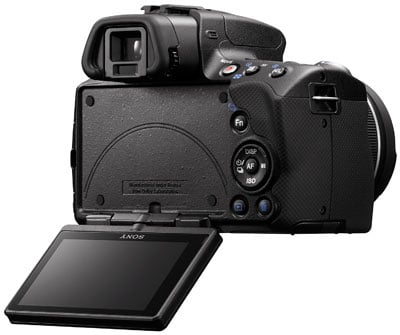 | |
The screen itself measures 3in with 920k dots and a wide 16:9 aspect ratio. This means HD videos or stills shot in the 16:9 ratio will fill the screen, but photos taken at the camera’s native 3:2 aspect ratio will occupy a smaller portion of the screen, measuring 2.6in on the diagonal with black bars running down either side. These bars are however used to display extended shooting information.
In contrast, Panasonic’s Lumix GH2 employs a 3in screen with 460k dots and a slightly narrower 3:2 aspect ratio. This means stills shot in the 3:2 ratio will fill the screen, while 16:9 content, such as HD video, shrinks a little vertically with black bars above and below and an image measuring 2.8in on the diagonal.
There’s always going to be a compromise with a screen that’s used to display content with different aspect ratios, and you should ideally go for one which matches your dominant shooting format. If you mostly shoot 16:9 content, the Sony is obviously preferred, but for 3:2 or a mix, the GH2’s screen area is better-exploited than the Sony. The higher resolution of the Sony screen does however show finer details though, so there’s pros and cons to each implementation.
While it’s important to compare screen shape, resolution and articulation, the biggest difference between the A33 and GH2 displays is the latter is touch-sensitive. While swiping through menus or tapping desired options is a novelty you’ll either love or hate, the GH2’s touch-screen does have at least one genuine benefit over conventional screens: the ability to tap the subject you’d like the camera to focus on. This is exploited to particularly good effect while recording movies on the GH2 as you can simply tap the screen to ‘pull-focus’ between subjects without recomposing or touching the manual focusing ring.
Sony Alpha SLT-A33 Live Histogram | Sony Alpha SLT-A33 Dual-axis Levelling Gauge | |
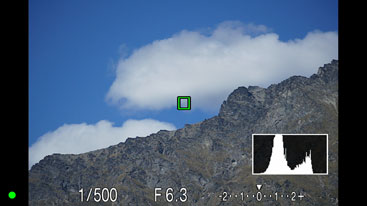 | 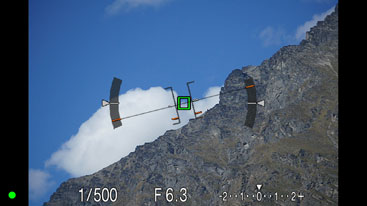 | |
Just before wrapping-up this section, we should note the SLT-A33 offers not just Auto and Manual control over screen brightness, but an additional ‘Sunny Weather’ option in the menu. This greatly increases the screen brightness and while some highlight areas inevitably become burnt-out as a consequence, it genuinely makes the image much more visible in direct sunlight. The Display options also offer an alignment grid (with markings for the video capture area), a Live Histogram and a neat dual-axis levelling gauge.
Sony Alpha SLT-A33 viewfinder
As a 100% Live View camera, the SLT-A33 is equipped with an electronic viewfinder. These have pros and cons compared to the optical viewfinders on traditional DSLRs. On the upside, the image in the A33’s viewfinder is noticeably bigger than DSLRs costing a similar amount, and it also enjoys 100% coverage and the opportunity to super-impose colour graphics and guides. Unlike an optical viewfinder, it can also be used to film video, which is useful in bright conditions.
| Sony Alpha SLT-A33 Viewfinder simulation (grabbed from Sony promotional video) | |
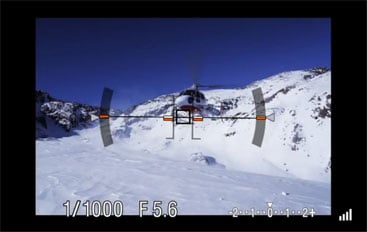 | |
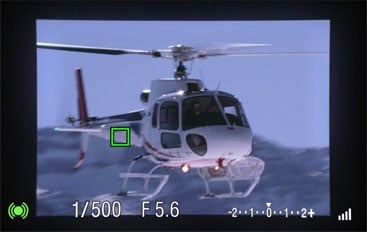 | |
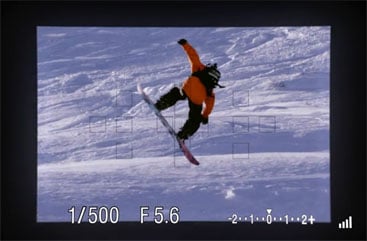 | |
On the downside, you’re never in any doubt you’re looking at an electronic image. Bright highlight details can often become saturated into pure white areas and despite the A33 having a high resolution panel, there’s still only a finite amount of detail visible. The display technology which switches the colour of each dot to simulate a full colour image can also result in tearing / rainbow artefacts with fast motion: quickly pan the camera or glance from one side of the image to the other and some people will notice coloured edges to objects. To be fair some notice this more than others, but those who do will find it quite distracting at times.
All 100% Live View cameras to date also suffer from a performance issue during fast continuous shooting, where the image displayed between frames isn’t live, but the previous shot played-back. This can make it hard to track action as the only feedback you have is the previous shot taken, which doesn’t show what the actual subject is doing right now. In contrast an optical viewfinder gives a brief glimpse of what’s actually happening between frames, allowing you to easily follow the action and recompose as necessary. While you can compensate for this to some degree when shooting action with a Live View system, it only works with predictable subjects. If the action is varying in speed or direction it becomes difficult to impossible to keep it centred in the frame. If you drop the A33’s shooting speed to low, it has sufficient processing muscle to offer a brief glimpse of live action between frames, but at its top speeds, you’ll only have the previous frame to guide you.
So with the pros and cons of electronic viewfinders duly noted, how does the A33’s compare against the competition? The SLT-A33 appears to employ a 4:3 shaped panel in its viewfinder, but only uses a 16:9 shaped active area; this occupies the full width of the panel, but is cropped vertically. Sony quotes the viewfinder as having 1,440k dots, but we believe this is for the entire panel including the unused portions above and below. Most 1,440k dot viewfinder panels have an 800×600 pixel resolution which corresponds to a 4:3 shape; if this is the case, the 16:9 active area of the Sony A33’s viewfinder would only use 800×450 pixels, or around 1,100k dots in total.
Either way, the 16:9 active shape of the viewfinder matches that of the screen with the same subsequent pros and cons: 16:9 material, such as HD video, obviously fills the entire area, while 3:2 content is positioned in the middle with black bars down the left and right sides. If the viewfinder panel is indeed a squarer shape, it’s a shame Sony didn’t exploit the extra area to expand the 3:2 frame vertically rather than crop it horizontally. As it stands though, even with a 3:2 image sporting black bars on all sides through the A33’s viewfinder, the active image itself remains large – indeed much more so than the optical viewfinders on similarly-priced DSLRs which look almost tunnel-like in comparison. This makes it even more satisfying when you switch the A33 to 16:9 and find the 3:2 frame expand horizontally to fill the full width of the viewfinder.
Coincidentally the Panasonic GH2’s viewfinder also shares the same shape as its screen, although for this model, it’s a narrower 3:2 shape than the Sony. Unlike the Sony though, the GH2’s viewfinder appears to use the entire panel area, which coupled with a higher quoted resolution of 1,530k dots (852×600 pixels) allows it to display an image which looks more detailed. It’s also worth noting the GH2’s viewfinder image appears roughly the same width as that on the A33, so 16:9 content actually looks around the same size on both. This then gives the GH2 the advantage when shooting 3:2 content as it expands the image vertically, rather than shrinking it horizontally. The 3:2 image on the GH2 looks huge in comparison to the Sony, and also contains more pixels: 852×600 compared to 675×450, should the A33’s quoted resolution of 1,440k dots indeed apply to a 4:3 panel as suspected.
Again we’re forced to speculate on the Sony numbers, but the bottom line is the GH2’s viewfinder does look a little more detailed than the A33, not to mention larger for 3:2 content. While we noticed the rainbow / tearing effect on both viewfinders, it was also more pronounced on the A33, perhaps as a result of its lower active resolution. In short, the GH2’s viewfinder was preferred over the A33, but again both enjoyed the benefits of an image that’s bigger than all but the best DSLRs, along with 100% coverage and super-imposed graphics. And despite being beaten on viewfinder quality by the GH2, the A33 does boast a useful dual-axis level gauge that’s absent on the Panasonic (see top screen grab).
Now check out our Sony Alpha SLT-A33 Features page to find out more about the focusing, stabilisation, sensor, image processing, and of course its HD movie mode.
Sony Alpha SLT-A33 lenses, focus, sensor and drive
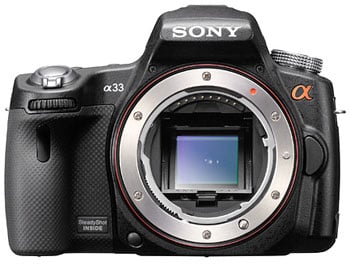 | |
|---|---|
The Sony Alpha SLT-A33 employs an A-mount for lenses and is compatible with the complete range of Sony lenses and third party models designed for the Sony or Minolta AF systems, including Sony’s DT models. All lenses attached to the SLT-A33 can exploit the camera’s built-in SteadyShot stabilisation, and since the A33 employs the same physically sized sensor as previous cropped-frame Alphas, all lenses effectively have their field of view reduced by 1.5 times.
It’s important to add the phase-change AF system will also work with any Alpha lens. This may be an obvious statement if discussing an Alpha DSLR, but it means the SLT-A33 can continuously autofocus while filming video with any lens in the Alpha catalogue. This gives it a key advantage over many mirrorless EVIL cameras, which have smaller native lens catalogues to start with and often suffer from further restrictions regarding continuous AF.
|
The counter-benefits of EVIL camera systems are quieter focusing from native lenses and the opportunity to exploit a massive range of third party lenses via adapters. But again the native lens selections for EVIL cameras currently remains small – especially for Sony’s own NEX E-system – and once you mount third party lenses, they become manual focus only. The big benefit of the A33 over EVIL cameras, particularly those from Panasonic, is full AF compatibility with a large existing lens catalogue, and of course the added benefit of enjoying stabilisation with each and every one.
Depending on your region, the SLT-A33 is available body alone, or in one of two lens bundles with either the DT 18-55mm f3.5-5.6 SAM alone or this and the DT 55-200mm f4-5.6 SAM in a twin lens kit. The DT 18-55mm SAM looks, feels and operates much like rival 18-55mm kit lenses. As you zoom from wide to telephoto, the barrel retracts and extends again, with the physically shortest position around the 35mm focal length. There’s no manual focusing ring to speak of, so like other kit lenses, you’ll be grabbing and rotating the narrow end section. This section therefore also rotates during autofocus, which means users of polarising filters may need to readjust after focusing.
The SAM designation refers to a built-in ‘Smooth Autofocus Motor’. Don’t expect equivalent speed and operating noise to Sony’s higher-end SSM lenses though – in terms of focusing speed and mechanical noise the DT 18-55mm SAM is pretty much the same as Canon’s EF-S 18-55mm IS. If you fancy a classier general-purpose zoom from day-one, we’d recommend the Carl Zeiss DT 16-80mm f3.5-4.5, a lens which delivers excellent image quality albeit without a fast and quiet SSM focusing motor. If you’re filming video without an external microphone, you need to be aware of focusing noise too, as many of the Alpha lenses will be heard quite audibly by the built-in microphones.
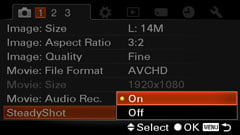 |
Like all Alpha DSLRs before it, the SLT-A33 is equipped with sensor-shift image stabilisation to combat camera-shake. This moves the entire sensor platform in two axes and is branded by Sony as SteadyShot. Sony claims the system is good for between 2.5 and 4 stops of compensation depending on the lens and shooting conditions, and like recent Alphas it’s enabled or disabled from a menu option rather than with the physical switch of earlier models.
As with all sensor-shift stabilised solutions, the major benefit is that it works with any lens you attach, new or old, wide or long, prime or zoom. As a 100% Live View system, the A33 technically could preview the stabilising effect on-screen or through the viewfinder, but in our tests, it didn’t appear to be applying it until the picture was actually taken. If this is the case, it may save battery power, but feels like a missed opportunity when composing with longer lenses. Like the Alpha DSLRs before it though, the SLT-A33 does at least have indicators in the viewfinder to show how hard the system’s working, or when it’s gone beyond its capabilities.
To test the effectiveness of the SLT-A33’s built-in stabilisation we took a serious of photos with the 55-200mm zoomed-into an equivalent of 300mm where traditional photographic advice would recommend a shutter speed of approximately 1/300 to eliminate camera shake. Our sequence started at 1/320 and reduced by one stop each time until 1/20. You can see results at 1/20 with SteadyShot disabled and enabled below.
Sony Alpha SLT-A33 SteadyShot with DT 55-200mm at 200mm | ||
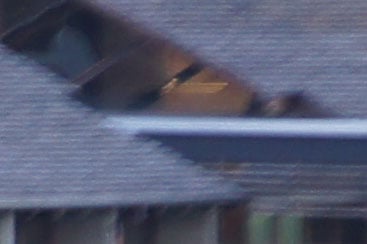 | 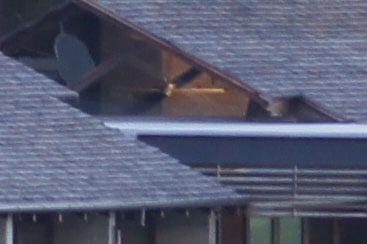 | |
| 100% crop, 1/20, 55-200mm at 200mm (300mm equivalent), SS off | 100% crop, 1/20, 55-200mm at 200mm (300mm equivalent), SS on | |
With SteadyShot stabilisation disabled, the slowest shutter speed we could handhold a sharp result at 200mm on the conditions of the day was 1/160. With SteadyShot enabled, we managed a pretty sharp result at 1/20 moments later, corresponding to three stops over the unstabilised version, or four over what conventional wisdom would recommend. This is a good result for the SLT-A33, which lest we forget can apply stabilisation to any lens you attach, making it more flexible than rivals which relay on lenses with optical stabilisation. It’s a shame Sony doesn’t appear to offer a preview of the stabilisation as you compose the shot – which would have been handy at longer focal lengths – but having it built-into the body remains a very valuable facility.
Sony Alpha SLT-A33 focusing
The Sony SLT-A33 boasts unique autofocusing capabilities: it may employ 100% Live View composition, but couples it with the quick and continuous phase-change autofocus system of a traditional DSLR.
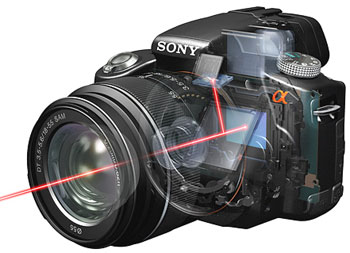 | |
Sony achieves this unique combination with a fixed, semi-reflective mirror. Most of the light passes through the mirror to expose the main sensor and deliver Live View, but a smaller portion is always reflected up to a phase-change AF sensor – the Sony promotional diagram, right, illustrates the optical path. This is unlike a DSLR where the mirror flips-up to expose the main sensor during Live View, thereby bypassing the phase-change AF system entirely. This is why conventional DSLRs are forced to use contrast-based autofocus during Live View, which is normally much slower.
Note Sony refers to this technology as a translucent mirror – hence the acronym SLT for Single Lens Translucent – but it’s arguably better to refer to it as a semi-reflective or semi-transparent mirror. While translucent can be used to describe something that’s semi-transparent, most primary definitions describe it as ‘transmitting light but causing sufficient diffusion to prevent perception of distinct images’ – just like a frosted bathroom window, and thereby obviously not ideal for photography. The correct technical name for the mirror in the SLT cameras is a ‘pellicle’ type although for the purposes of this article we’re happy to refer to it as a semi-reflective mirror, as that’s exactly what it’s doing: reflecting a small amount of light, but allowing the lion’s share to pass through to the imaging sensor.
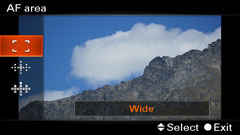 |
|---|
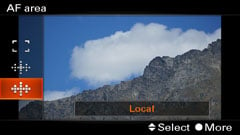 |
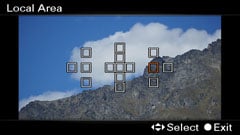 |
Terminology aside, the Sony A33’s autofocusing in Live View is a revelation, with the 15-point AF system snapping onto subjects as quickly as composing with the optical viewfinder on a traditional DSLR. Better still, unlike the contrast-based systems on most Live View cameras, the A33 confidently supports continuous AF for tracking subjects. Technically it can even beat a traditional DSLR in that regard, as the semi-reflective mirror ensures the A33 keeps focusing even as you take the shot, whereas a DSLR must briefly switch to a predictive system while its mirror is raised.
Where the system really impresses though is for video. Since the phase-change AF system is always active, it can be used to deliver quick and continuous autofocus while filming. This is unlike most video-equipped DSLRs which either perform a laborious contrast-based search every few seconds, or don’t bother at all and force you to manually pull-focus instead.
The phase-change AF system of the SLT-A33 isn’t just faster than most contrast-based systems – it’s cleverer too. One of the rarely-mentioned benefits of phase-change AF is its ability to know which way to turn the focus to achieve a sharp result. Under ideal conditions this allows it to focus straight onto the subject without drifting back and forth to confirm. In comparison a contrast-based system has to briefly go beyond the point of focus, before returning again to confirm it. This back and forth process is known as searching or hunting, and can be very distracting in video. In contrast, if the A33’s AF system can successfully lock-onto a subject, it’ll do so with the minimum of fuss.
This is all very impressive, and we have more information on the video autofocus in our movie mode section below, but Sony’s SLT implementation is not without its downsides. Most obviously the semi-reflective mirror always reflects approximately 30% of the incoming light to the phase-change sensor, leaving less for the imaging sensor to work with. This means greater amplification is required to achieve the same sensitivity as a conventional camera system using the same sensor, and hence higher noise levels. Some owners have also reported ghosting issues with the semi-reflective mirror under certain conditions, although we didn’t experience those in our tests; that said, astro-photographers or night cityscape fans capturing bright details against a dark background should do further research.
A lesser-known disadvantage is phase-change AF systems rely on very strict manufacturing tolerances. If the AF and imaging sensor distances don’t exactly match, you could find yourself with a slightly out-of-focus subject even when the AF sensor reports perfection. The effect of lenses front or back-focusing is fairly well-known for traditional DSLRs, but has never been an issue for Live View cameras until now as they’ve always taken contrast-reading direct from their imaging sensors. The Sony SLT cameras lull you into a false sense of security with their 100% Live View composition, but thanks to their phase-change AF sensors are equally susceptible to lens calibration issues as conventional DSLRs.
Sony’s so confident of its phase change system that it doesn’t offer a contrast-based alternative, nor any kind of AF fine-tuning or micro-adjustment. It’s literally blind faith, and as we discovered, sometimes misplaced. Our A33 sample suffered from occasional focusing issues and inconsistencies during tests where a number of images were slightly out of focus, despite the AF system assuring the contrary. This occurred under strict conditions where the camera was mounted on a tripod, and the static subject placed directly under an AF point at a distance of about 15m. In each case, the camera reported a focused image, but while some were perfectly sharp, others were slightly off.
|
We tested the A33 side-by-side with the Panasonic Lumix GH2, which employs a traditional contrast-based AF system. Since contrast-based systems take measurements directly from the imaging sensor, they eliminate any front or rear focusing issues. Problems can still occur, but it’s revealing that under the same test conditions, the Lumix GH2 enjoyed a much higher success rate with focusing then the A33.
Now this may just be a calibration issue with our particular sample, but like all phase-change systems, it’s important to know they’re not infallible. Contrast-based systems for all their speed issues can be more consistent and accurate.
Some are quick too. Panasonic has put a lot of effort into proving contrast-based systems can be as fast or even faster than phase-change systems, and its Lumix GH2 is one of the quickest around. Indeed in our tests with their respective kit lenses, the GH2’s contrast-based AF was visibly faster than the Sony A33, while again avoiding calibration issues. It was also much quieter in operation.
The caveat here is the GH2 is only quicker for Single AF modes. Switch both cameras to Continuous AF and the A33’s phase-change system will more confidently track fast action with less searching, although it has to be said, the GH2 wasn’t far behind.
The bottom line is the SLT-A33 may have one of the most innovative AF systems around, and one which thrashes the Live View and movie focusing on traditional DSLRs, but don’t assume it’s infallible, nor the overall best out of the current hybrid cameras.
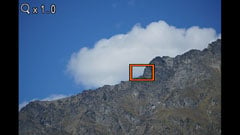 |
|---|
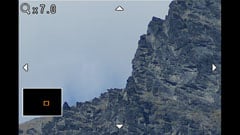 |
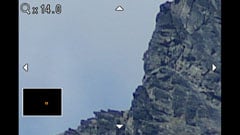 |
Looking at the actual focusing options in more detail, the SLT-A33 lets you set the AF mode to AF-S, AF-C or AF-A (automatic), and the AF Area to Wide (automatically selecting from all 15 AF points), Spot (which only uses the Central point), or Local (where you manually choose one of the 15 points).
There is the option to enable Face Detection, but while the camera’s software will follow subjects with a familiar square frame on-screen, it won’t actually focus on them unless they fall behind one of the fixed 15 AF points. Remember the A33 only has phase-change AF at its disposal, so it has no means to auto-focus on anything outside of its 15 AF points.
This certainly has the potential to confuse, as while the camera may successfully place a frame over a face and follow it around the frame, it might not actually be able to focus on it. This is slightly misleading in our opinion and could lead to some disappointment when photos of people aren’t always as sharp as you’d expected.
To be fair, the A33 will only turn the face frame green to confirm focus when it does fall over an AF point, but many will assume it’s simply working like Face Detection on a contrast-based system, which can track and focus across most of the frame. This is another area where the Lumix GH2 takes the lead, as its conventional contrast-based AF system can track and focus on faces almost anywhere on the frame, and as mentioned above, lock-onto them quickly.
Finally, the SLT-A33 offers magnified focusing assistance, although you’ll need to enable it first in a menu. Once enabled, you press the Trash button to superimpose a frame on the screen. Next move the frame to the desired area using the rocker control, before pressing Trash again to magnify it by 7 times or again for 10 times – see screen-grabs left
We used this facility in our test shots to confirm the phase-change system had got it right, or to correct it if it was slightly off, as was sometimes the case in our High ISO Noise composition.
Sony Alpha SLT-A33 sensor and processing
 |
|---|
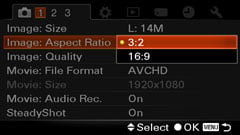 |
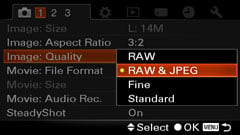 |
The Sony Alpha SLT-A33 is equipped with a 14.2 Megapixel Exmor CMOS sensor, measuring 23.4×15.6mm. Like Sony’s other cameras to employ APS-C sized sensors, the field of view is reduced by 1.5 times, so the effective focal length of all lenses is effectively multiplied by 1.5 times – so the 18-55mm SAM kit lens delivers coverage equivalent to 27-83mm in full-frame terms.
The SLT-A33’s sensor delivers 3:2 shaped images with a maximum resolution of 4592×3056 pixels; lower resolution options are available at 7.4 and 3.5 Megapixels, along with cropped 16:9 options at 12, 6.3 and 2.9 Megapixels. Images can be recorded with Fine or Standard compression, or in Sony’s ‘ARW’ RAW format, either by itself or accompanied by a Fine JPEG. Best quality Large Fine JPEGs typically measured around 5MB each in our tests, but for complex scenes increased to around 8MB; RAW files weighed-in at around 14.5MB each.
The SLT-A33’s sensitivity ranges from 100 to 12,800 ISO in single EV increments, although switching to Multi Frame Noise Reduction adds an extra high 25,600 ISO option. We’ll discuss Multi Frame Noise Reduction in more detail below, and you can of course see comparative results demonstrating it and the standard sensitivity range in our High ISO Noise test pages.
Contrast, saturation and sharpness are applied in a range of +/-3 steps using a selection of five colour Creative Styles. There’s also a Black and White option, although this simply dispenses with saturation and sadly doesn’t replace it with any coloured filter effects.
Like all Sony cameras, the SLT-A33 offers a variety of contrast-enhancement options applied with its Dynamic Range Optimizer, or DRO for short. DRO can be set to Auto, or to one of five manual levels from weak to strong.
To put the A33’s DRO to the test we photographed our standard low-light composition (which contains dark shadows and saturated highlights) using each of the settings. Below are examples showing the extremes of the range, with DRO disabled on the left and set to the maximum Level-5 on the right. It’s clear from both the photo and the histogram below right how DRO has boosted the shadow areas, along with brightening mid-tones, although the backlit windows remain saturated.
Sony Alpha SLT-A33 DRO Disabled | Sony Alpha SLT-A33 DRO Level-5 | |
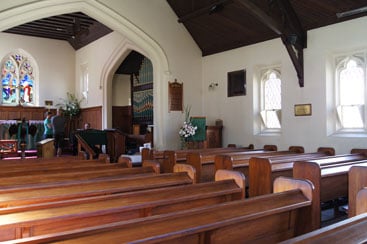 |  | |
 |  | |
0.8 secs, f8, 100 ISO | 0.8 secs, f8, 100 ISO | |
The DRO options can be accessed via the Fn menu or the dedicated D-Range button. From there you can also select the A33’s High Dynamic Range, or HDR options. The HDR mode shoots three different exposures in quick succession, then automatically combines them into a single image. You can either choose the Auto HDR option, or six manual settings which set the exposures from 1 to 6EV apart. Note HDR is not available when shooting in RAW.
To put the A33’s HDR to the test we photographed our standard low-light composition (which contains dark shadows and saturated highlights) using each of the settings. Our Sony SLT-A33 HDR results page shows examples of each HDR setting, but for a quick comparison, below are two images showing HDR off and then set to the maximum 6EV setting. Looking at the histogram alone, you’d be forgiven for thinking the A33’s Auto HDR has simply squashed the DRO Level 5 range seen above with a greater peak in mid-tones. But looking at the actual images reveals the HDR version has retrieved some of that lost highlight detail from the previously saturated windows. This illustrates the benefit of the HDR mode over single-frame DRO, although to better protect highlight detail, you may prefer to use it in conjunction with a little negative exposure compensation.
Sony Alpha SLT-A33 DRO / HDR Disabled | Sony Alpha SLT-A33 HDR 6EV | |
 | 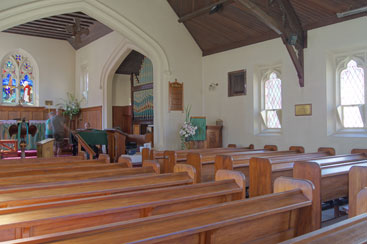 | |
 |  | |
0.8 secs, f8, 100 ISO | 0.8 secs, f8, 100 ISO | |
While HDR aficionados may have preferred an additional option to shoot more than three frames (or have broader bracketing options for HDR assembly on their computers), it remains a very powerful feature to find in-camera. The maximum 6EV range is particularly impressive, although most will find the more modest options deliver a subtler and more realistic effect; again see our Sony SLT-A33 HDR results page for examples of each setting in action.
Sony Alpha SLT-A33 shooting modes
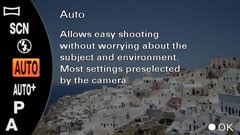 |
|---|
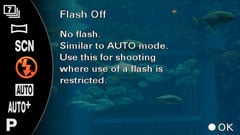 |
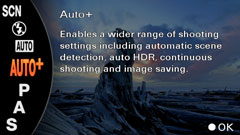 |
The Alpha SLT-A33’s mode dial offers the choice of Auto, Flash Off, Auto+, SCN, Sweep Shooting, and Continuous Advance Priority AE, in addition to the traditional Program, Aperture Priority, Shutter Priority and Manual modes.
Auto delivers a fairly basic automatic exposure mode without, as far as we can tell, any scene detection; Flash Off is the same, but forces the popup flash not to fire.
The Auto+ mode is where it starts to get interesting, as it not only employs scene detection to choose one of nine presets, but also includes two of the A33’s more innovative multi-frame modes: Handheld Twilight and Auto HDR. This builds upon earlier Alpha models which may have shared some of the same modes, but forced you to deliberately find and deploy them yourself. Now the Auto+ mode can exploit their often excellent results as it sees fit.
Now when you’re handholding photos in very dim conditions, the SLT-A33 could opt for Handheld Twilight mode to protect from camera shake while also reducing visible noise. Meanwhile if the camera detects a composition with large amounts of very dark and light areas, like a strongly backlit building or landscape, it’ll select Auto HDR. Each mode captures six or three frames respectively before combining them into one, so obviously there’s a risk an Auto+ user might begin to lower the camera while it’s still shooting. In both cases though, the camera clearly states its intention, so there shouldn’t be too many surprises.
In practice we found the SLT-A33 playing a little safe and only deploying these modes in fairly extreme conditions when we’d have personally selected them a little sooner. But you do of course have the chance to activate them yourself whenever you want, and we’re just pleased to find Sony adding them to an Auto mode in any shape or form.
To illustrate Auto+ in action we shot the following scene in Auto and Auto+ modes, deliberately adjusting the composition until the latter selected its Auto HDR mode. This may be a little contrived, but illustrates how Auto and Auto+ evaluated and dealt with the same strongly backlit scene.
Sony Alpha SLT-A33 Auto mode | Sony Alpha SLT-A33 Auto+ mode (with Auto HDR) | |
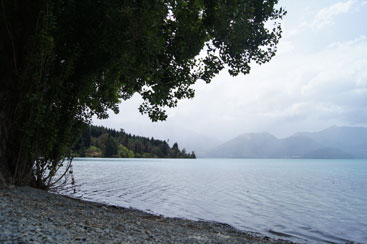 | 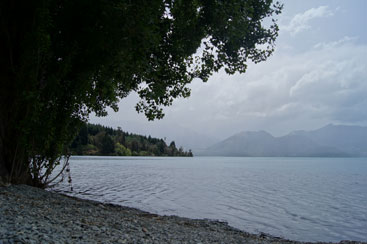 | |
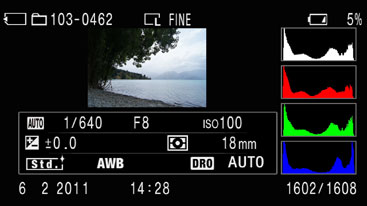 | 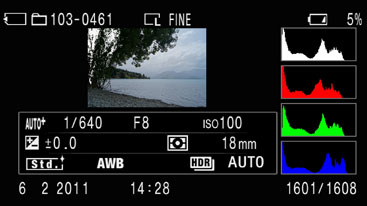 | |
1/640, f8, 100 ISO | 1/640, f8, 100 ISO | |
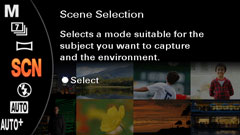 |
|---|
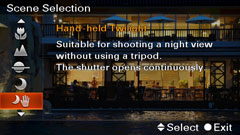 |
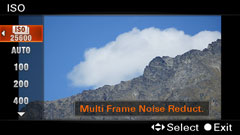 |
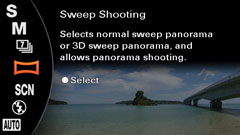 |
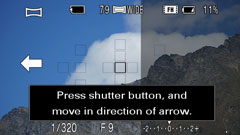 |
If you like the automatic life, but prefer to point the camera in the right direction, the SCN position offers eight presets including Portrait, Sports Action, Macro, Landscape, Sunset, Night View, Handheld Twilight and Night Portrait; each is accompanied by a page which describes the mode with a sample image of how it might be used.
The most interesting of the Scene presets is Handheld Twilight mode, or HHT for short, which fires-off six frames in roughly one second before combining them into a single image. HHT is designed for static subjects in low light and combines its frames to reduce visible noise. The sound of the shutter firing six times in quick succession is far from discreet and guarantees some head turning from anyone within ear-shot, but the results can be excellent.
The only problem with Handheld Twilight is it’s fully automatic with no control over the shutter, aperture or sensitivity. Wouldn’t it be nice to enjoy the same multi-frame noise reduction in any mode, such as Program or Aperture Priority, where you could also choose the sensitivity? Well now you can with the SLT-A33 using its appropriately-named Multi Frame Noise Reduction settings.
You’ll find these at the top of the main ISO page in a scrolling menu. Simple choose 100-25600 ISO in single EV increments, or Auto, and the A33 will fire-off six frames and combine them into one to reduce visible noise. This is a very welcome addition to the A33 to say the least and more than makes up for the loss of Anti Motion Blur mode.
Indeed we’d say Handheld Twilight and the new Multi Frame Noise Reduction modes are so important and effective that we’ve devoted entire results pages to each. They’re a key benefit the A33 has over the competition and are some compensation for the semi-reflective mirror reducing the effective sensitivity of the camera. See our Sony SLT-A33 Handheld Twilight results and Sony SLT-A33 Multi Frame Noise Reduction results.
Returning to the main mode dial, the next option is Sweep Shooting. This refers to Sony’s cunning panorama facilities which again exploits the quick continuous shooting capabilities to fire-off a burst as you pan the camera across a scene. The camera then automatically stitches the frames into a single panoramic photo within mere seconds.
Like the NEX cameras before it, you can choose the panning direction from left to right, right to left, or vertically from down to up or up to down. You can also select between standard or extra wide image sizes, and again the resolution matches the NEX cameras: 8192×1856 or 12416×1856 pixels for horizontal panoramas, and 2160×3872 or 2160×5536 pixels for vertical panoramas. If preferred you can shoot horizontal panoramas with the camera held in the portrait orientation by simply selecting the vertical panorama option.
In use the Sweep Shooting is certainly impressive. As you shoot, a frame on the screen guides you through the pan and asks you to repeat if you’re moving too fast. If you stop moving before the maximum image width, the camera simply records a grey area you can crop-out later. At first glance the results look great, although like most panoramic stitching there can be errors depending on the subject, distance and focal length. If the subject moves during the pan, such as a boat bobbing or tree swaying, there’ll almost certainly be some ghosting, while anything at close range may suffer from parallax effects. But zoom-out, keep your distance and the results can look wonderful. We’ve included two samples below: the first shows a best case scenario with a distant static landscape, while the second shows what happens when you try an incorporate a moving subject.
Sony Alpha SLT-A33 2D Sweep Panorama samples |
| Both images taken with 18-55mm at 18mm (27mm equivalent) |
The 3D Panorama feature of the previous NEX models is also available on the SLT-A33, but now presented as an option in the Fn menu. This exploits the panning motion to generate depth information which can be interpreted by a compatible 3D TV over HDMI to deliver a 3D image. You also get a 16:9 image option along with the standard and wide sizes, although the maximum height of all three is 1080 pixels. In 3D Panorama mode, the SLT cameras record two files: a standard 2D JPEG which can be viewed and used as normal, and an accompanying MPO file which contains the depth information; the MPO files typically measure between 1 and 3MB each.
It sounds like an amazing feature, especially considering there’s only one lens, but the conditions are stricter than the normal Sweep Panorama mode. First it’s only available for horizontal pans from left to right or right to left. Secondly you’ll need to get the panning speed just right or the SLTs will abort and ask you to try again.
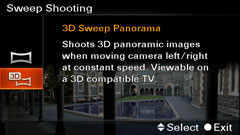 |
|---|
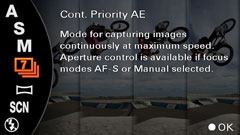 |
Since the 3D mode creates a normal 2D JPEG image in addition to its dedicated MPO depth file, you might wonder why you wouldn’t shoot all your panoramas in 3D mode for ‘future-proofing’. Well you could, but the 3D mode shoots at a lower resolution than the normal 2D Panorama and is limited to horizontal pans, not to mention demanding a stricter motion. But if you’re happy with a 1080 pixel height and carefully shooting all your panoramas horizontally, then you may as well opt for the 3D mode and enjoy their extra depth when connected to a 3D set.
Ultimately while the 3D effect is nowhere near as good as that of a decent 3D animated movie, it remains a fun and impressive capability, given there’s only one lens on the camera. When the subject matter is right, the effect can look good, and is yet another unique string to the Alpha bow.
New to the SLT-A33’s dial is the Continuous Advance Priority AE mode. This rather long description simply lets the camera shoot at a slightly higher continuous speed of 7fps where the only penalty is having to use the maximum aperture if the focus is set to Continuous. The reason the aperture is set to the maximum in this mode is to eliminate the need for it to open and close between frames. With it wide-open, the AF system can continuously autofocus without worrying about the aperture potentially closing down, leaving the shutter to fire as fast as it can.
The camera still faces the same buffer restrictions as when shooting in the normal Continuous High mode though, so you’re looking at capturing no more than around 17 Large Fine JPEGs in a burst; the difference there though is doing so in around 2.4 seconds, which in our tests confirmed the quoted speed of 7fps.
Continuous shooting speed is an area where the SLT-A33 comfortably takes the lead over rivals like the Panasonic Lumix GH2. Not only does the A33 offer more confident continuous autofocusing, but it’ll do it at its maximum quoted speed of 7fps, whereas the GH2 slowed to 2fps in our tests when tracking the action. Shame the 100% Live View system means following the action is difficult, but you can’t have everything. We have more details about continuous shooting below.
Wrapping-up the exposure modes are the traditional PASM options on the dial. The SLT-A33 offers shutter speeds from 1/4000 to 30 seconds plus a Bulb option in Manual; the maximum flash sync speed is 1/160.
Adjusting the aperture and shutter speed in their respective Priority modes is as simple as turning the finger dial, although we were a little disappointed not to find Shift in Program mode – an annoying trend in Sony cameras. Exposure compensation is available in a +/-2EV range with 1/3EV increments.
Bracketing is available from the Drive menu with three frames taken in the choice of either 1/3 or 2/3EV increments. This may seem a little restrictive until you discover the built-in High Dynamic Range (HDR) option. White Balance bracketing is also available.
Sony Alpha SLT-A33 Continuous shooting
While other manufacturers traditionally reserve fast continuous shooting for their pricier cameras, Sony has been carving a very welcome niche for itself by offering very respectable frame rates on affordable models. The SLT-A33 is no exception, boasting 6fps continuous shooting, boostable to 7fps if you’ll accept auto exposures and the aperture wide open.
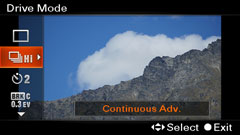 |
|---|
 |
At this price point there are of course further restrictions, most notably a fairly modest buffer which means you’ll only be capturing around 15 best-quality JPEGs before the camera begins to stall. But the good news the SLT-A33 really can deliver its quoted frame rates for those short bursts.
When set to AF-S and fitted with a Memory Stick PRO Duo or Class 6 SDHC card, we fired-off 17 Large Fine JPEGs in just under three seconds, corresponding to a rate of approximately 6fps. Set to AF-C for continuous autofocus, the SLT-A33 slowed down a fraction to deliver around 5.5fps, but that’s still very respectable for the money.
Switching to Standard quality JPEGs extended the buffer by a few shots, but still typically less than 20 in practice. The SLT-A33 alternatively offers a Continuous Low option which shoots at 2.5fps, although this again didn’t extend the total number of frames by a great deal, stalling after around 25.
As mentioned above, there’s also a quicker 7fps option. To select this you’ll need to turn the SLT-A33’s mode dial to Continuous Advance Priority AE, a rather long name that’s mercifully shortened to a 7 icon on the dial. This switches the SLT-A33 to auto exposure with the aperture locked wide open to eliminate the time taken to adjust it between frames. In practice it really works too, delivering 7fps in our tests, albeit this time only for around seven frames in total.
So the SLT-A33 is limited by its buffer to short bursts, but at least it can deliver fast speeds during that time. This is in some contrast to Panasonic’s Lumix GH2 which managed just 2fps with Continuous AF enabled.
This sounds like a big win for the SLT-A33 over its hybrid rival, but sadly neither are all that appropriate for fast action photography due to their reliance on Live View for composition. Like most cameras with 100% Live View systems, the image displayed between frames in continuous bursts is not actually live, but the previous image played-back. So while you have the shutter release held during a burst, you’re actually looking at where the action was, not where it is right now.
This causes a problem when the action requires panning, as you have no feedback as to where to point the camera other than the previous photo you took – by which time the subject will of course have moved-on. As such, panning on live view systems involves a certain degree of blind anticipation and adjusting the camera further than the image you’re viewing might suggest. It’s something you do get used to, but it’s nowhere as intuitive or easy as the optical viewfinder in a traditional DSLR which thanks to the speed of light gives a brief glimpse at what’s happening between frames, allowing you to recompose as required.
But if the action is moving predictably, or straight towards or away from you, then the SLT-A33’s 6 and 7fps continuous shooting modes are quite usable; they’re also absolutely fine when shooting bursts in portraits to maximise your chance of capturing the right expression. The slower 2.5fps option also gives the SLT-A33 just enough time to display a live image between frames if preferred for instant feedback.
To see just how big an issue it is in practice, we took the SLT-A33 to photograph the famous Shotover Jet boats in Queenstown which race past at high speeds and perform 360 degree spins. As expected, it wasn’t all that easy to keep the boat in the centre of a tight frame while panning, and if it deviated from a predictable straight path we frequently lost its extremities at the frame edges. Having roughly 15 frames at your disposal also meant you had to start shooting at just the right moment to avoid filling the buffer too early.
 |  |  |  |  | ||||
 |  |  |  |  | ||||
But when the boats were moving predictably or spinning on the spot, we found we could keep the action centred even at the highest frame rates. And while the framing and tracking was no easier than the Panasonic Lumix GH2, the SLT-A33 at least managed to shoot up to 3.5 times quicker in our tests. Overall an impressive performance for a camera at this price point, although again if you’re serious about shooting action, especially unpredictable subjects, you’ll ultimately be better-off with a traditional DSLR.
Now it’s time to check out the video recording capabilities in our Sony Alpha SLT-A33 Movie Mode page. Alternatively if you’re not interested in movies, find out how the SLT-A33 compares against its rivals in terms of image quality in our results pages and sample images gallery. Or if you’ve already seen enough, head straight to our verdict.
Sony Alpha SLT-A33 Movie Mode
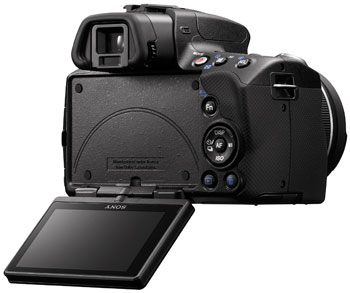 | |
|---|---|
| Sony Alpha SLT-A33 capture area: stills vs movies | |
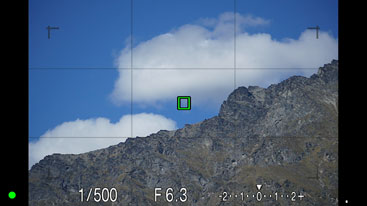 | |
| Crop marks indicate area captured during video |
The Sony Alpha SLT-A33 offers Full HD video with stereo sound and continuous autofocus, and you can start recording in any mode by simply pressing the dedicated record button to the right of the viewfinder. When you start recording you’ll notice the field of view shrink a little, so clearly the A33 isn’t using its sensor’s full area for video. This means wide angle lenses won’t be quite as wide when filming video, although at least the Grid display option previews the cropped area that will be captured once you start recording – see right.
You can choose to record in AVCHD format at 1920×1080 pixels, or MP4 format at either 1440×1080 pixels (stretched out to 1920×1080 for playback) or 640×480 pixels. AVCHD footage is recorded as MTS files with interlaced video at either 50i or 60i depending on the region of the camera, while MP4 files are encoded as progressive video at 25fps or 30fps, again depending on the region; the frame rates cannot be adjusted.
Audio is recorded using stereo microphones built-into either side of the viewfinder head, or you can alternatively connect an external microphone to a 3.5mm jack on the side of the camera. The port can power compatible microphones, but it also works with those employing a phantom source; we tried the SLT-A33 with a Rode SVM and it worked fine. Limiting the usefulness though are the non-standard accessory shoe on the top of the camera and lack of manual recording levels.
The maximum recording time in any mode is 29 minutes, but this reduces to around 11 minutes on the A33 when SteadyShot is enabled – presumably due to overheating issues. Full HD AVCHD files consume around 120 Megabytes per minute, so you’ll hit the 29 minute mark with a file measuring around 3.5GB. The MP4 files are additionally limited by size and stop recording when they hit 2GB, which will get you about 20 minutes in the 1440×1080 mode.
|
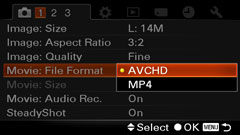 |
|---|
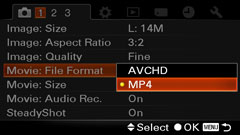 |
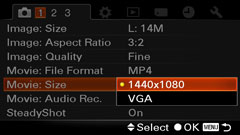 |
Sony quotes a formatted 16GB card as being able to record just under two hours of Full HD AVCHD, just under three hours of MP4 at 1440×1080, or ten and a half hours at VGA resolution – although remember those earlier limitations of 2GB for MP4 files and 29 minutes for all modes. If you’re using an SD memory card, you’ll need Class 4 or faster to support Full HD.
The movie inherits the current White Balance, Creative Style, Exposure compensation, AF area and Metering mode. By default the exposure is fully automatic with no control over aperture, shutter or ISO, although you can adjust the exposure compensation both before and during filming. Aperture control is possible in Aperture Priority, but only when the camera and lens are set to Manual focus, the reason for which will become clear in a moment.
By default the focusing is set to continuous, and rightly so since the A33’s unique combination of Live View composition with full-time phase-change AF delivers far better results than any video-equipped DSLR we’ve tested.
As explained earlier, the SLT-A33 employs a fixed semi-reflective mirror which always reflects a small portion of the incoming light to a phase-change AF sensor, while allowing the rest to pass through to the imaging sensor. This allows the camera to continuously autofocus using its quick and accurate phase-change system while filming video – a pretty unique capability in today’s market.
Literally in contrast, existing DSLRs and EVIL cameras are forced to use contrast-based autofocus while filming video as the latter don’t have alternative phase-change systems and the former bypass theirs during filming. Unfortunately most contrast-based systems are insufficiently quick to deliver discreet and continuous autofocusing while filming, leaving most cameras to either deliver a disappointing AF experience during video or simply not bother and force you to focus manually instead.
This is where the SLT-A33 really scores, confidently, quickly and continuously adjusting its autofocus while filming. Better still, since phase-change systems (under ideal conditions) know which way to turn the focus to achieve a sharp image, the SLT-A33 can lock onto subjects without the usual searching back and forth. With the right subject matter, it’s very satisfying to watch the SLT-A33 refocus in one move while rarely over-shooting or searching. You can see an example of this in the clip below, which simply cannot be matched by video-equipped DSLRs at the time of writing.
| ||
|---|---|---|
|
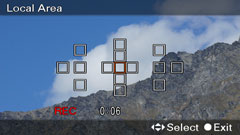 |
|---|
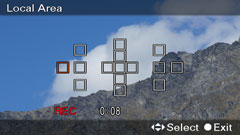 |
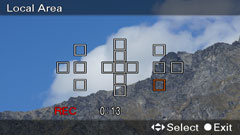 |
In the example above we chose the Local AF area option and manually selected the central focusing point, so we could force the camera to focus on the desired object simply by pointing at it. We found this much more successful than the default Wide area option which automatically selects from the 15 available AF points and as such may end up concentrating on the incorrect subject.
Fixing the AF point gives you control over the system, although obviously prevents refocusing on a different subject in the frame without recomposing. Considerately though, the SLT-A33 allows you to adjust the active AF point while filming by simply pressing the AF button on the back and using the rocker. In theory this could allow you to pull focus between subjects on opposite sides of the frame without recomposing. In practice they’ll of course need to fall under an available AF point and you’ll also need to select it quickly to prevent the camera from refocusing on something in-between. Pressing the buttons quickly can also wobble the camera, not to mention be picked-up by the internal microphones, so it’s not an ideal process, but it is at least possible.
Note: since the A33 only supports continuous autofocus while filming, there’s nothing stopping it from making constant adjustments, which under the wrong conditions could be visually (and audibly) distracting. You can of course take somewhat extreme action by switching the camera and lens to Manual Focus (and back again if desired) during a clip, but it’s hard to do so without wobbling the camera and making a loud click.
Suffice it to say the camera is confident at tracking subjects as they approach or retreat. In the next clip we filmed this approaching gondola / cable car with the kit lens fully zoomed-in, and the SLT-A33 managed to keep it in sharp focus for the majority of the sequence. So far this has proven impossible to match with a video-equipped DSLR, and would also be very hard to achieve with manual focusing.
| ||
|---|---|---|
|
If you’ve only filmed video with a traditional DSLR, you’ll undoubtedly be impressed by the continuous AF capabilities of the SLT-A33, but there are some caveats to be aware of. Arguably the most important is that phase-change AF sensors require bright lens apertures to operate – typically f5.6 or faster.
In practice this means the SLT-A33 has to fix the lens aperture at (or close to) its maximum in order to autofocus while filming. This has the joint side-effects of a shallow depth-of-field whether you like it or not and a reliance on adjusting the ISO and shutter speed only for exposure control. The latter can cause problems in bright conditions, as with the aperture wide open, the SLT-A33 is forced to use relatively quick shutter speeds even at the lowest ISOs. This in turn can cause choppy-looking video, especially with motion or panning. The only solution to this problem is to fit neutral density filters.
|
If you’d like a smaller aperture, either for slower shutter speeds or to increase the depth of field, then you’ll need to switch the SLT-A33’s body and lens to manual focus. This then allows the movie mode to inherit the selected f-number in Aperture Priority, although obviously you’ll lose the autofocusing.
So if you want autofocus while filming on the SLT-A33 you’ll need to accept a shallow depth-of-field, no control over exposure (other than compensation), and potentially choppy footage in bright conditions thanks to fast shutter speeds. It’s also worth noting the kit lens is quite audible when autofocusing, and even the operation of the quietest Sony lenses will be picked-up by the internal mics.
It’s also important to remember while phase-change AF during video is technically impressive, it’s not the only game in town. Panasonic’s Lumix GH2, arguably the A33’s biggest rival in the hybrid market, may employ contrast-based autofocus, but deploys it sufficiently quickly to deliver continuous AF capabilities. In use this allows the camera to confidently refocus on different subjects during filming, and while the technology inevitably involves a little searching, it’s pretty successful on the whole.
The GH2 also sports additional tricks including a touch-sensitive screen which allows you to pull-focus between subjects by simply tapping them on screen, full manual exposure control, adjustable recording levels, a 1080 / 24p option, broader AF areas including genuine face detection and tracking, Single AF modes in addition to Continuous, clean HDMI output to drive an external monitor, and a selection of lenses which focus very quietly. So while the SLT-A33 under ideal conditions can refocus without searching at all, the Lumix GH2 delivers a more sophisticated video recording experience overall which will be preferred by serious videographers or independent film makers; you can see how it compares under similar conditions on our Panasonic Lumix GH2 Video Samples page.
To be fair though, the SLT-A33 is aimed at a consumer market which should be more than satisfied by its video capabilities; indeed it’s hard not to be delighted with them compared to rival DSLRs. If all you want is continuous AF while filming, it won’t disappoint. You can find more movies filmed with the SLT-A33 on our Sony Alpha SLT-A33 Video Samples page. Alternatively if you’ve seen enough movies, find out how the SLT-A33 compares against its rivals in terms of image quality in our results pages and sample images gallery. Or if you’ve already seen enough, head straight to our verdict.
Sony Alpha SLT-A33 video samples
Here are four sample videos filmed with the Sony Alpha SLT-A33 and SAL1855 SAM 18-55mm kit lens using its best-quality 1920×1080 AVCHD mode. Our review sample was from a PAL region, so the clips are in the 50i format. Registered members of Vimeo can download the original files by clicking the links below each window; these take you to the Vimeo page where the video is hosted and the link to download the actual file can be found under the ‘About this video’ section in the lower right. We used VLC Player to watch the MTS clips under Windows.
This review is a work-in-progress. When it is complete, we’ll have full details about the SLT-A33’s movie mode in the Features section.
All of the clips below were filmed with the camera set to Program mode. As such the movie mode operated at the maximum aperture of the kit lens to allow its phase change AF system to operate. Since AF was enabled on the lens, the movie mode used continuous autofocusing for all these clips. Listen carefully and you’ll hear the lens adjusting its focus.
| |
|---|---|
|
In our first clip above, we filmed with the A33 handheld and panned it slowly around before zooming the kit lens in and back out again. The first thing to notice is the CMOS sensor avoids the vertical streaking on saturated highlights which plagues CCD-based compacts. Towards the end of the clip you’ll see the lens being zoomed-in and out again, and like all DSLRs with manual zoom rings, this is neither a smooth or pleasant result. It’s impossible not to twist the body wile zooming handheld, and the basic construction of the kit lens also means a smooth zoom is nigh-on impossible throughout its range. This wobbling brings up the problem of a rolling shutter with the infamous jello effect. The bottom line? Until motorised zooms arrive for DSLRs, it’s best to keep the focal length fixed or only make minor adjustments from a tripod.
| |
|---|---|
|
In our second clip, above, we’ve mounted the A33 on a tripod, disabled stabilisation and smoothly panned from left to right. This delivers a much preferable result, and we paused at the start in case you’d like to take a video grab to check out the quality.
| |
|---|---|
|
For our third clip we moved indoors to a dimly lit bar, where we handheld the camera for a pan. There’s no control over the sensitivity in the movie mode, but the large sensor in the A33 has delivered a fairly low noise result, even with the modest aperture of the kit lens.
| |
|---|---|
|
In our fourth clip we’ve put the A33’s continuous AF system to the test. This is the default mode if AF is enabled, and for predictable results we’d recommend fixing the AF point. Here we fixed it to the centre, forcing the camera to only autofocus on that point. As we approach the coffee cup and pull back again with the lens zoomed-in, you can see the camera adjust its focusing to keep the subject respectably sharp. Then when we point the camera at a bottle, you can see the system pause before refocusing. As we move the camera between the bottle and the rear of the cafe, you can see its response time, along with the AF speed of the SAM 1855 kit lens. It’s not the fastest or quietest lens in the range, but the gentle refocusing is actually quite satisfying, rather than having it almost instantly readjust on a pricier lens. Either way, the impressive thing here is the fact the camera is focusing at all during its movie mode. Matching this with, say, Canon’s DSLRs, would have required constant focus-pulling and been virtually impossible to achieve. It’s a very impressive capability on the A33.
| |
|---|---|
|
Our final clip puts the AF system to the test by tracking a subject that steadily approaches. We zoomed the kit lens in on the approaching cable car, fixed the focus point to the centre, and kept it aimed at the Skyline logo. As the cable car approaches, the camera successfully adjusts its focusing to keep the subject sharp even when it’s only a couple of meters away. This is another very impressive demonstration of the A33’s autofocusing during its movie mode, and a key advantage it has over rival DSLRs.









